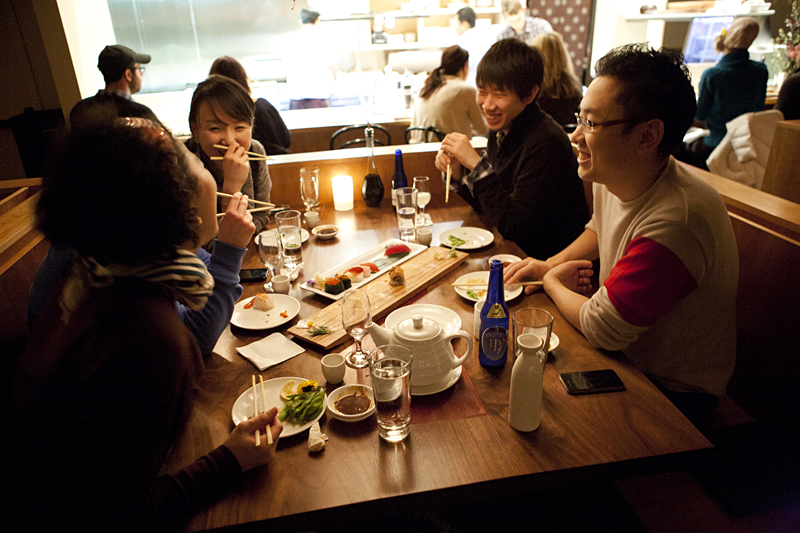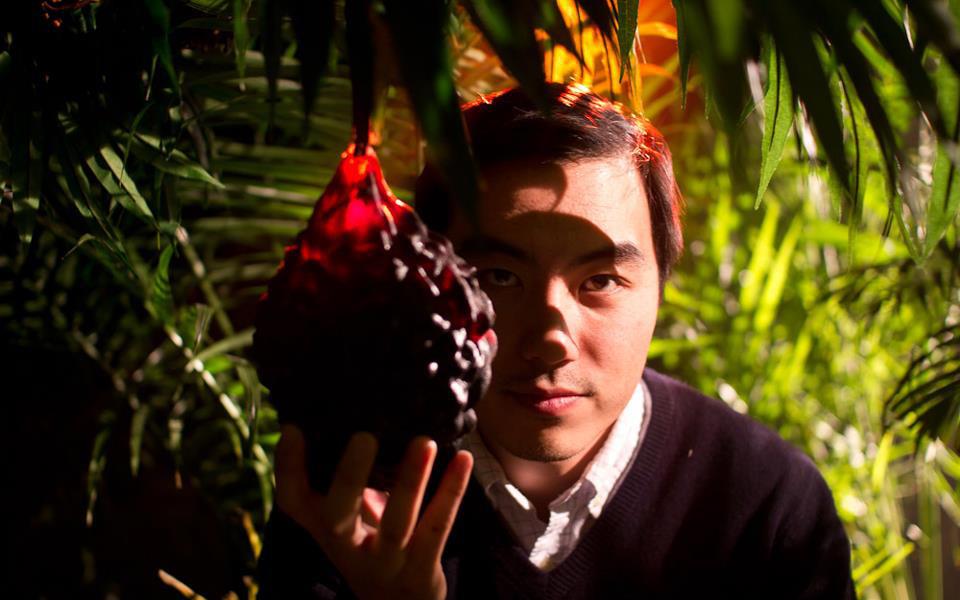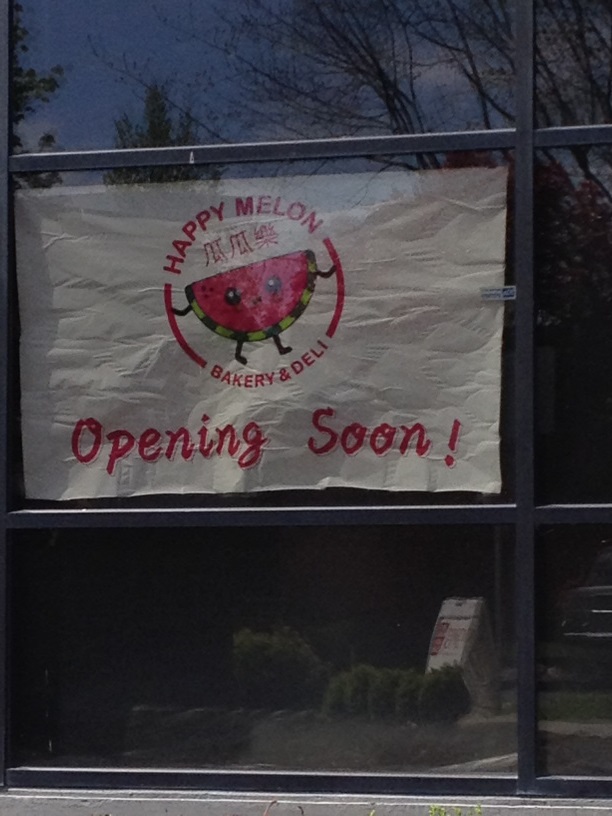When frozen yogurt last had a moment, the aproned kids behind the counter were the gatekeepers of the granola, sunflower seeds, raspberries, and other goodies used to lure the ice-cream crowd into buying a dessert that sounded suspiciously like what counted as the final course in fat-camp cafeterias. Now, not so much as a sneeze guard comes between Americans and their yogurt toppings: A frozen-yogurt supplier in Arkansas, the home state of TCBY, recently told Nation’s Restaurant News that none of the new shops he added to his client list in the past year dared to deny its customers the chance to heap their to-go bowls with gummi bears, Cocoa Pebbles, jelly beans, and rainbow sprinkles in previously unsanctioned proportions. “People like to mix it up when it comes to creating their own frozen-yogurt dishes,” Sugar Creek Foods’ Bud Gunter explained to the paper.
Americans haven’t yet stepped behind the sushi bar, but if chefs ever did ape what’s worked for fro-yo joints by introducing DIY roll design, the results would likely look like the gaudy pastiches produced by Momiji, the extraordinarily stylish Japanese restaurant which opened three months ago on Capitol Hill. There are 40 rolls on Momiji’s specialty roll menu, and another dozen or two on the nightly specials menu. Restaurants often achieve those kind of roll numbers through repetition, assigning different cutesy names to rolls made with crab and avocado; crab, avocado, and cucumber; and crab, avocado, cucumber, and salmon.
But Momiji has assembled a pantry so deep that the only near-constants are avocado and lots of mayonnaise. There isn’t much overlap between a Hotter than Hell (spicy tuna, yamagobo, cilantro, seven-spice tuna, habanero masago, citrus truffle oil, and green onion) and a Lucky Leprechaun (seasoned pickled vegetables, cucumber, cilantro, mango, avocado, and mango shiso sauce). Pop quiz: Which ingredient doesn’t show up in a Momiji roll? a) strawberry habanero sauce b) limes c) pico de gallo d) lemon-jalapeño sauce. If you’re looking for “None of the above,” you win.
Like the monstrosities that eager yogurt eaters concoct when they realize they can have hot fudge, caramel, and mashmallow sauce, the rolls at Momiji are immense. Even when divided into eight to 10 pieces, each roll segment is nearly as big as a yo-yo. In Momiji, Steven Han, the restaurateur responsible for Umi Sake House and Kushibar, has created the Carnegie Deli of sushi bars.
What’s so strange about Momiji is how thoroughly the menu clashes with the setting. Bloated rolls are usually served side by side with sake bombs and shrimp tempura in badly lit lounges that either offer weekly karaoke nights or can’t afford the video equipment. But Momiji’s stunning interior is a study in reticence and calm.
After buying the old Dawson Plumbing building for $1.5 million, Han put together a team of craftsmen whose former clients included universities and art museums. Whidbey Island woodworker Craig Yamamoto carved the front door—which opens onto a rail-car-shaped bar, where a woven light fixture that resembles a mummified blimp hangs overhead—and all of the tables in the dining room beyond. The dining room is configured like a horseshoe with a glassed-off Zen courtyard at its center. The restaurant will fling open its full-length windows come summer so diners can sit outside, but the array of rocks and Japanese maple trees designed by Junji Miki now functions as an unspoiled diorama.
Everywhere there is wood. Sitting in the leg of the dining room that houses the sushi bar feels very much like being ensconced in the world’s most bespoke pencil case. This is a beautiful setting for exploring the restaurant’s sake list, which I, not being a sake expert, ran past Seattleite Bruce Ryan, who’s received his Advanced Sake Professional certification from the Sake Education Council. “It’s a really nice list,” he told me, citing the mix of styles, regions, and brands.
Momiji helps demystify sake selections by offering flights and appending tasting notes to every glass and bottle, but I wish Japanese restaurants—particularly ones that lean so heavily on “crab-mayo mix”—would provide glossaries with their sake lists. It’s helpful to remind customers that a sake identified as a nama daiginjo is an unpasteurized sake made with the most highly polished rice. It’s also worth ordering, Ryan says. “Tedorigawa is a highly respected Japanese sake maker which consistently makes delicious sake,” he explains, “and I’ve rarely seen it on U.S.A. sake lists.”
The cocktail list is lengthy, so I felt lucky to have landed upon a lovely Katana 12, made with 12-year-old Suntory scotch, plum wine, cranberry juice, and ginger. But if I have the opportunity to keep exploring, I’ll probably investigate the parade of shochu cocktails, featuring the distilled Japanese liquor that always seems to snag a spot on year-end lists of coming trends.
While the kitchen gamely tries to emulate the serenity that seeps from Momiji’s central garden and informs its sakes, well-intentioned stabs at culinary refinement come across as awkward and silly, like Walt Disney’s dancing hippo in a tutu. The menu’s first page is devoted to dishes appropriate for kaiseki, the multicourse Japanese meal service that emphasizes artistry and harmony. Balancing flavors and textures is so critical to the kaiseki concept that the interplay of individual dishes matters as much as what’s put—or more accurately, meticulously arranged—on each plate.
Yet Momiji serves kaiseki a la carte, a term that ranks just below jumbo shrimp on the gourmet oxymoron list. Of those items, the housemade tofu wasn’t available when I dined there, but I sampled a braised pork belly that consisted of three lumbering hunks of sweaty swine meat, posed in a pyramid with a roasted shisito pepper, two limp green beans, and a smear of mayonnaise on top. The dish looked heavy, and overcooking didn’t help it.
Mayonnaise foibles abound at Momiji, which has as many cooked small plates as sushi rolls on its menu. Sliced filet mignon anchors a plate bedecked with shredded lettuce, tomatoes, and generous swirls of horseradish-spiked mayonnaise, all of which add up to a flavor doppelgänger for a roast-beef club sandwich. Mayonnaise is also the dominant flavor in a baked seafood dish, which I guess is what Japanese-Americans in Minnesota bring to potlucks. All four of the “bakes” Momiji offers appear to be the heated insides of sushi rolls: The Dynamite Bake I tried was a warm, creamy mess of clams, shrimp, and sweet crab mayonnaise, baked to a greasy golden finish and strewn with green onions.
Still, it’s possible to get a good hot meal at Momiji.The udon isn’t revelatory, but it has all the requisite elements—a dashi-rich broth, chewy noodles, and a scattering of scallions—to become perfectly acceptable over the course of spirited conversation and a second cocktail. A fried soft-shell crab, wearing just the right amount of batter, is excellent, although ginger drowns out the wild greens with which it’s served. Garlicky grilled short ribs, dressed with soy sauce and tinged with smoke, shouldn’t be missed.
Sashimi at Momiji isn’t pristine: The tuna and salmon I tried tasted fresh, but were a touch raggedy. It’s fascinating, though, eating unadorned fish at a restaurant that prides itself on eight-ingredient rolls, much like seeing a movie star before she goes through makeup.
There’s no use hiding from the rolls, no matter how much you disdain putting cream cheese on eel and calling it a Bad Boy. I might advise wariness around fried rolls such as the Crunchy Cali—a classic Momiji preparation of crab mayo, avocado, and cream cheese—since hot rolls taste like misguided rice pudding (a sensation enhanced here by Momiji’s use of extra-sweet rice). But there’s nothing terribly objectionable about a Sounder Roll, made from spicy yellowtail, avocado, asparagus, seared crab, and wasabi aioli, among other things.
It’s odd eating undignified rolls in such a gorgeous room, but the duality shouldn’t discourage a reconnaissance visit to Momiji. The sake list is smart, the service competent, and the short ribs terrific. Consider an extra dollop of mayo the cost of admission.
Price Guide
Filet mignon $12
Tempura udon $12
Soft-shell crab $11
Garlic short ribs $11
Crunchy Cali roll $9
Sounder roll $16








